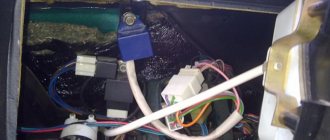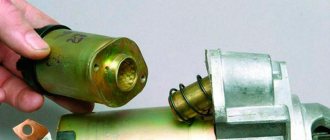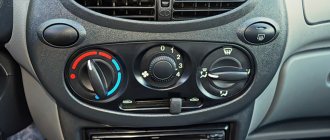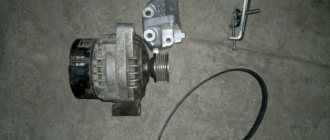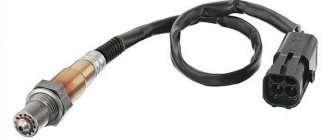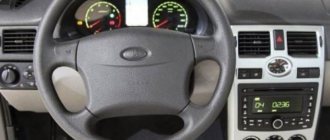The safety of the driver and passengers depends on the proper operation of the optics. If the headlights on a VAZ 2106 car do not light up, then it is better not to drive the car anywhere, especially at night. The article discusses the design of optics, possible lighting malfunctions, and what tuning can be done.
Low beam does not work when the engine is running
- Registration
- Entrance
- To the beginning of the forum
- Forum Rules
- Old design
- FAQ
- Search
- Users
Look: 1 - terminal under the ignition switch. I had a bad contact there and as a result the terminals burned and the casing melted. 2 - All connections to the mounting block, especially loaded (thick wires are mostly pink). I had a very similar situation. While there are few consumers, everything is fine, but no matter how many things you turn on, the terminal overheats and the voltage drops, though not everywhere, but in some circuits.
1. Disconnected and connected the connector under the lock - if we are talking about it. Did not help. 2. I see. When the light went out, I touched the battery terminals - they were absolutely normal, no overheating. There was no smell of anything burnt either. There are no bells and whistles (additional consumers), everything is standard. What happens during these five minutes while it stands is unclear. When everything works, there are no signs of a wiring fault - everything flashes, lights up, lights up, lights up, etc.
And the tension disappears everywhere for me
if the car is absolutely dead from an electrical point of view, it can only be something with two wires coming from the battery - minus to ground and plus.
Well, there would be a lack of contact in the block, “why turned green”, etc. (see above) - this should also appear when the engine is running, the wiring is still there
Even if something is wrong, at least something should be on, well, brake lights, a beep on the steering wheel - or I’m wrong.
Source
Problem with fuses, switches and relays
If you notice that your high beam has completely disappeared, then the problem is unlikely to be incandescent lamps. Such simultaneous failure of both lamps is practically impossible and can only occur if the voltage relay regulator on the generator breaks down, but in this case the problem would affect not only the headlights, but also all automotive electrical equipment.
First of all, we advise you to start your search with fuses - look in the instruction manual for information on fuses, namely the exact location of the fuses responsible for the operation of the high-beam lamps. Take them out and check their condition, they may have burned out. The next step is to check the condition of the steering column switch. Note that this problem is quite common in VAZ cars. If the switch and fuses are good, all you have to do is check the status of the high beam relay. You will need a multimeter for this test.
What to do if the headlights blink at idle
Based on the principle of operation of electrical devices in a car, it is concluded that the light blinks at idle speed of the engine when the generator malfunctions. But this needs to be checked accurately, for which the following is done:
- The engine starts and the headlights turn on. The car should run like this for up to 20 minutes.
- The measuring procedure is performed using probes connected between ground and terminal “B+”.
- The values that you received must be written down on a piece of paper, and then checked with the numbers indicated in the technical documentation of the vehicle.
Experts say that for most cars the normal voltage is 14-16 Volts. Even with minor deviations, there is a possibility of the voltage regulator breaking down. To solve this problem, it needs to be replaced.
Important! Following basic safety rules when checking your generator will protect you from negative consequences for your health. Therefore, it is prohibited to check by short circuit, connecting terminals “B+” and “D+”, etc.
d.
Based on the test results, you can get the following indicators:
- The voltage is below normal - a possible solution is to tighten the belt drive that goes from the motor pulley to the generator.
- Voltage higher than normal usually indicates loss of generator functionality.
Fuses, switches and relays
If your high beam has completely disappeared, then it is unlikely that the problem is incandescent lamps - the simultaneous failure of two lamps is only possible if the generator voltage relay-regulator is faulty, which will most likely affect not only the headlights.
First, check the fuses - find the fuses corresponding to the high beam lamps in the owner's manual, remove them and make sure that they have not blown.
The next step will be to check the functionality of the steering column switch - this malfunction occurs quite often on rear-wheel drive VAZ cars.
After making sure that the relays and switches are working properly, check the functionality of the high beam relay - use a multimeter to do this. If you do not know how to use a multimeter, we recommend that you read the descriptions, photos and videos on the Internet.
Thanks for subscribing!
Troubleshooting and repair.
1. Check and replace the light bulb. You can check the light bulb; a) visually (see the burnt out thread) b) with a device (for lack of resistance) c) replacing it with a known good one.
Advice: - when replacing a light bulb, you should not touch the glass with your hands, this will reduce the life of the lamp to 1 day (oil from your hands getting on the glass leads to an increase in temperature and, as a result, the lamp burns out on the first day) If you touch it with your hands, just wipe the lamp with alcohol , that is, degrease. — use lamps recommended by the manufacturer.
2. Find and replace the fuse. The high beam fuse in all cars is designated as in Fig. 2
Rice. 2 Or the inscription in English: fuse beam Tip: Always when replacing or checking fuses, use the pliers that are located in the fuse box and look like this:
When searching for a fuse box, use the instruction manual; it will indicate the location of the box, the designation and rating of the fuses.
3. Search and check the high beam relay. Finding the high beam relay is similar to finding a fuse: -take the operating instructions and look for the relay block. - we look for the designation or marking of the high beam relay (or beam relay) - we check or change it to a known working one.
Tip: To replace, you can use the low beam relay (on 99% of cars they are interchangeable).
If there is not a separate relay, but a light control unit, then the entire unit must be replaced.
4. Steering light switch. This is where I advise you to go straight to the service station (or study the manufacturer’s manuals for a long time and carefully). The fact is that checking or replacing the switch on some cars with an airbag is associated with a risk to life and health (the airbag is triggered abnormally, the face is usually at the level of the steering wheel, you can imagine the effect, especially since there have already been cases).
5. Checking the mass. This applies primarily to old machines with a long service life. We take the connector from the headlight and use the device to measure the resistance to ground (usually a brown or black wire), it should not exceed 3-5 Ohms, if we look for the ground attachment point according to the diagram and clean it or use a paint sprayer.
6. The cause of electrical wiring malfunction may be: - wear (break); — oxidation (poor contact); — abnormal intervention of “crooked hands” (“specialists” in installing alarms, fog lights, car radios and other “special extras”). Finding faulty wiring, as a rule, is associated with the availability of manuals for a given car, which may not be freely available. Therefore, if you are not confident in your abilities, I strongly recommend turning to specialists (it will be cheaper). That's all. Good luck on the roads!
Also see other articles from the category
Some owners of VAZ-2106 cars have encountered such an unpleasant problem as non-working high beams. This problem, although not critical and allows you to use the car almost without problems, still needs to be eliminated. We will talk about the reasons for this malfunction and how to eliminate it in our article.
The peculiarity of the structure of the headlights of the VAZ-2106 is that the low and high beam lamps are located in different headlight housings, which greatly simplifies the search and solution of the problem.
One of the main reasons for this malfunction is considered to be problems with relays and fuses. In addition, sometimes situations arise when, when switching to high beam, your low beam is completely turned off or the headlights on one side (low and high) go out. This problem in most cases occurs due to oxidation of the ground contact on some headlight.
The left high beam headlight on the VAZ 2106 does not light, both on the low beam are on, what is the reason?
circuit breakers. may have oxidized. rotate the fuses in their sockets.
A intact fuse differs from a blown fuse by the presence of a jumper between the contacts (inside the fuse)
Is the high beam indicator light on the dash lit? So it's not a fuse. Look at the lamp and the wiring to it.
Well, it’s easy to sniff a two-ruble coin instead... But the burnt-out light bulb doesn’t ring, it’s black and you can see a break inside….
look at the wires, I had this happen, the wires melted next to the fuses
A light bulb with wiring will help you.
another car will help you
I have a VAZ 2106 and this is the reason why neither high beam is on, but both low beams are on, what could be the reason!!! help me please
Common problems
Other, more common problems that may cause low beam headlight bulbs to not light even after replacement include the following:
- Damaged fuses - contacts are oxidized or the protective element is melted. In the VAZ 2106 they are located under the dashboard.
- The low beam relay has failed. A continuity check of the electrical circuit with a multimeter is required.
- Poor ground contact on the path from the fuse block to the optics module. It is necessary to clean the oxidized joint.
Recommendation! To double the degree of illumination from the low beam in the VAZ 2106, you can connect the third contact in the high beam module - since a lamp with two filaments is also installed there.
Car headlights - a guarantee of your safety
Safety behind the wheel plays an important role for every motorist.
In this regard, drivers should remember some factors that ensure their safety. However, the most important thing is that, while driving, you need to clearly see the road along which the car is moving. This is why driving lights are so important. They provide the driver with good visibility in cloudy weather or at night.
Today, the auto parts market offers several types of headlights.
All of them can be divided into several categories.
- Of course, something needs to be said about the fog lights. As the name suggests, fog lights are designed to provide additional illumination of the road during thick fog. Most cars come with a set of fog lights from the factory. Typically, this type of headlight is installed on the front bumper. However, to increase the illumination area, you can purchase an additional set of headlights yourself. Some car brands provide wide lighting angles initially.
- When traveling on unfamiliar roads, the driver must have good visibility in front of him. For this you need a powerful high beam. Here, car spotlights produced by some companies come to the driver's aid. But it is necessary to keep in mind that such headlights are not intended for city roads, since their light can blind other drivers. But for country roads this type of lighting will come in handy.
- On the one hand, we can talk about the uniqueness of high beam headlights. They are typically placed lower than off-road headlights. However, their purpose is to improve road illumination in addition to low-beam headlights. For natural reasons, their light is directed forward, unlike fog lights. Before using high beam headlights, you need to remember that its brightness can blind drivers of cars in front. Therefore, it is better to turn it on when the track is empty.
- An auxiliary lighting system offers several benefits. First of all, it's a great way to stand out. Also, auxiliary lights will help others easily spot your vehicle at night. And finally, they help the driver to navigate well in the dark.
There are other types of headlights on a car. For example, xenon headlights or high intensity discharge lamps. The most important thing is to have a proper headlight leveling and cleaning system to get the most out of your vehicle.
Vote, did you like the article?
One of the high beam lamps has burned out
With such a malfunction, the high beam does not fail completely - as a rule, only one lamp turns off. Almost every car owner knows the solution to the problem in this case, but we will still remind you how to make a replacement:
- Unscrew the bolts securing the rim of the faulty headlight
- Turn the glass clockwise and pull the headlight out of the housing
- Disconnect wires from contacts
- Press the latch and carefully remove the light bulb
You can verify that the lamp is faulty by examining the filament (as is the case with ordinary household lamps). If the lamp is faulty, you need to purchase a new lamp and install it in place of the old one, without touching the glass with your hands. After that, reassemble everything in reverse order and make sure the high beam is working.
The “six” light acquires special importance when a motorist has to drive in conditions of poor visibility, in difficult weather conditions and at night. However, any driver must remember that defects in the vehicle’s electrical equipment system, one way or another, affect the functionality of the power plant. And this is despite the fact that the main electrical circuits are protected by relay elements, just as the lighting of the “six” is protected, the safety devices of which are routed to the vehicle’s fuse box.
On the VAZ 2106, the headlight relays, along with other main electrical equipment of this vehicle with high current consumption and high voltage, are connected via relay elements. The main purpose of the VAZ 2106 light relays, whose price is low, is to protect the switch contacts from energy overload.
Car enthusiasts often ask where the high and low beam relays are located on the “six” and what they look like. Let us explain that almost all relay devices, as well as the relay - voltage regulator, are located in the power plant compartment. The exception is the turn signal and hazard warning relays, which are located under the instrument cluster in the car interior, covered by a front panel. Both relays are identical in appearance (they can be easily found on the mudguard on the right as the car moves) and are located next to the battery charging indicator relay.
The electrical diagram of the light relay is located below:
On the general diagram of the electrical equipment of the “six” you can see at number 5 the VAZ 2106 low beam relay, and at number 6 the VAZ 2106 high beam relay, which are interchangeable elements. Also here you can see the integration of the main electronic devices of the vehicle into the general electrical supply circuit of the vehicle of this modification.
Relay for high and low beam "six"
As already mentioned, the standard high and low beam relays of the VAZ 2106 are absolutely identical, have similar catalog numbers (90.3747-10 or 113.3747-10), are of the same type as the initiation relay for the radiator fan device of the cooling complex of the power plant and can be replaced with each other friend.
To connect the light relay to the VAZ 2106, devices with item number 113.3747 are used, which are installed in a mounting-type block device. Similar devices are installed in the system to turn on the EDC fan device, heat the stern glass and produce alarm sounds.
The initiation voltage of the device at an average temperature of about 23 °C is within 8 V, and the resistance of the device winding at a temperature of 20 °C is 85 ± 8.5 Ohms.
Instead of products under catalog number 113.3747, it is allowed to use updated high and low beam relays VAZ 2106 90.3747-11 in a plastic case and with increased dimensions. It is also allowed to replace products 113.3747-10 with a mounting bracket with gadgets with fasteners under the nomenclature value 90.3747-10 with the same characteristics.
The automotive industry practices the production of light relays for the VAZ 2106 under the nomenclature numbers 902.3747 (version 11 - without fasteners and 10 - with fasteners), used on injection "sixes", because The device integrates an additional resistance to suppress interference, connected in parallel to the relay winding. For such high and low beam relays, the resistance between connectors “85” and “86” is 65 - 80 Ohms. They are interchangeable with the VAZ 2106 light relay
with the numbers 113.3747.
Bulb replacement procedure
Using a Phillips screwdriver, unscrew the bolts that are located around the entire circumference of the rim. In total, you need to unscrew three of them (if my memory serves me correctly), namely those that perform the function of a lock:
Now we turn the ring slightly clockwise and after that you can remove the reflector along with the glass, as shown in the photo below:
Next, everything is done very simply. You must first disconnect the wires leading to the lamp contacts:
And then squeeze the light bulb retainer (the ends of the thin metal latch) with two fingers:
Then we tilt it up and calmly remove the light bulb:
If necessary, we replace burnt out light bulbs, install new ones and reassemble everything in the reverse order. If you decide to completely change the headlight assembly, you will have to take a few more steps:
Electrical wiring
Electrical wiring is designed to supply electrical current to the consumer, in this case the high beam lamps. Problems with electrical wiring, partial lack of insulation, overheating of the wiring due to incorrectly installed fuses can cause a fire in the car, and you need to monitor the serviceability of the wiring as carefully as other mechanisms and devices of the car.
Important! A non-functioning high beam in conditions of insufficient visibility does not allow the driver to drive a car safely, and if problems arise with the high beam headlights on a VAZ car, knowledge of repair and diagnostics will help to quickly and effectively eliminate the problems that have arisen
Glass
When converting factory headlight units, acrylic or polycarbonate elements are used instead of tempered, heavy glass. When choosing, you should take into account the diameter of the new glass, adjusting it to the size of the standard blocks.
Acrylic headlights are made by heat shrinking using old glass as a matrix. The minimum thickness of a new plexiglass headlight is 4 mm. The advantages of an acrylic block are low cost and the ability to be manufactured in a workshop. The disadvantages include rapid wear of the part. Acrylic quickly becomes covered with microcracks after being hit by gravel thrown out from under the wheels of a vehicle in front, and loses transparency after overheating. It is recommended to additionally protect the headlights with armored film.
Polycarbonate headlights are two times lighter than glass and are characterized by increased resistance to mechanical damage. Compared to acrylic glass, polycarbonate glass does not become cloudy over time, does not lose light transmission, and is resistant to temperature changes.
Smoke from under the hood and smell in the car interior
Low beam doesn't come on
Why isn't the low beam on? If the low beam does not light up, then the following causes of the malfunction are possible:
- The low beam lamp does not light up. Our cars are equipped with double-filament halogen lamps, i.e. Both the low and high beam headlights are provided by one lamp, the different filaments of the lamp just light up. Replace the lamp with a known working one. To find out how to properly replace a lamp, see the article
- The fuse has blown. The low beam fuse has blown, check the fuse and replace it. You will find answers on how to find, check and replace the fuse in the article.
- The wires have oxidized. We look at the fuse block, namely the blocks of all tires to the fuse and relay block. They can become detached, poorly secured, or oxidize. Let's fix it. We also look at the wires connected to the lamp itself; the contact group of the headlight may have oxidized.
- Low beam power button. The fact is that the switch (button) for the low beam or side lights may have broken. The problem is typical: the wire has come loose or oxidized.
- The low beam fuse keeps blowing. This situation often occurs among owners of our brands. There may be 2 options:
- there is a short wire somewhere;
- again poor contact with the fuse.
If nothing helps you, then I advise you to call the wiring. If you are not comfortable with electricians, then it is better to turn to a professional.
Fuse box
The fuse box in Grant is located to the left of the steering column, near the light switches. To remove the cover and access the fuses and relays, pull the top left side of the cover towards you. It’s made conveniently, everything is at hand and you don’t have to climb anywhere when getting up from the driver’s seat. Maybe this is a hint that they will often have to be changed, or maybe just convenience - the developers know better.
F1 (15 A) - engine control unit, injectors, ignition coil, cooling fan relay, short circuit 2x2.
If you have problems with electronics, and replacing this fuse does not help, in the worst case scenario, you will have to reflash the ECU or replace it. Also, if this fuse blows, the injectors and ignition coil stop working, which makes engine operation impossible. Therefore, if the Grant does not start, check this fuse first.
F2 (30 A) - electric windows.
If they do not work and replacing the fuse does not help, try unplugging it completely or removing the terminal from the battery for a couple of minutes, then connect it again. In this way, all temporary errors should be reset and if this is the case, the power windows will work again.
F3 (15 A) - alarm. If it doesn’t work, check this fuse, as well as the emergency light button, its contacts and the functionality of the lamps.
F4 (20 A) - windshield wiper, airbag. If the airbag warning light on the instrument panel comes on, check this fuse. The problem could be either in it, or in the electronic unit, or in the pillows themselves.
If the windshield wiper does not work and this fuse is intact, also check relay K6, the power handle, the reliability of the connectors connected to it, as well as the electric wiper drive itself.
F5 (7.5 A) - terminal 15 of the ignition switch. If you have problems turning on the ignition, check this fuse, as well as the reliability of the wire connections to the lock terminals.
F6 (7.5 A) - reverse lamp. If it does not work, but this fuse is intact, check the lamp itself, as well as the contacts connecting the connectors to the headlight.
F7 (7.5 A) - Mass air flow sensor, adsorber valve, oxygen sensor, speed sensor. If the engine runs erratically, does not idle, or stalls spontaneously, the problem may be this fuse or the corresponding sensor. We already had an article on how to check the mass air flow sensor.
F8 (30 A) - heated rear window. If it does not work, check this fuse, the terminals connecting the wires to the heater, and the integrity of its elements.
F9 (5 A) - right side lamps
F10 (5 A) - left side lamps. If the dimensions do not light up, the problem may be in these fuses or in the lamps themselves, as well as their connectors. It wouldn't hurt to check the headlight switch on the dashboard.
F11 (5 A) - rear fog lights. If they do not work, but this fuse is intact, the problem may be in the switch on the dashboard or in the lamps themselves, as well as their connectors
F12 (7.5 A) - right low beam lamp F13 (7.5 A) - left low beam lamp. If the low beam does not work in two headlights at the same time, the problem may be in the K9 relay, or in the low beam switch and its contacts. If only one lamp does not light, it is most likely the fuse or the lamp itself that needs to be replaced.
F14 (10 A) - right high beam lamp F15 (10 A) - left high beam lamp. If both high beam headlights do not work, the problem may be in relay K7. If there is only one, replace the fuse and/or lamp.
Low beam does not work: reasons
So, proper lighting of the road while the car is moving is a very important factor that ensures the safety of the driver, his passengers and other road users.
While driving a vehicle, the driver needs to clearly see the road along which the car is moving.
High/low beam headlights are very important because they provide good visibility both at night and in cloudy weather conditions. Today there are several types of car headlights, which can be divided into the following categories:
- Main headlights using halogen, xenon, high-intensity discharge lamps, diodes, etc.;
- Fog lights - the main purpose is additional illumination of the road while driving in thick fog (most often, the manufacturer already supplies cars with a set of fog lights);
- Spotlight headlights - powerful headlights provide the driver with good visibility, especially when driving on unfamiliar roads (headlights are not intended for city driving, as they can blind other drivers);
At the same time, for low and high beams, as well as for fog lights, halogen lamps are most often used, designated by the type of base as R2, H1, H3, H4, H7, HB3, HB4.
As for the problem itself, if the low beam does not work, the reasons may be different. It is important that the cause of the malfunction of the low beam or high beam headlights is accurately determined. Here are some of the main reasons why the low beams do not light up:
- low beam lamps have burned out;
- the fuse threads have melted (since basically the power circuits of the left and right headlights are not interconnected and are protected by separate fuses, a failed one of the fuse elements can lead to the failure of one headlight), the malfunction is diagnosed visually. In case of difficult access to the mounting block, check the operation of devices receiving power from circuits protected by the same fuses;
- faulty headlight relay (lighting systems stop working, there is either low or high beam). The malfunction can be detected by ear, by turning on the headlights and listening to the sounds that arise; if short, loud clicks are heard, the relay is working properly; if there are no clicks, the relay is faulty;
The connectors of the electrical wires going to the headlights are not connected correctly or are not connected at all (for example, they forgot to connect them after repairs). In this case, only one of the two headlights does not light up.
- water entering the engine compartment of the car (oxidation of the “chips” at the junctions of the wires, as a result of which the “chips” cease to perform a conductive function). Diagnose the malfunction by checking all the named wires and connections suitable for the headlights;
- voltage surge in the on-board network (both lamps burn out at the same time);
- other non-standard reasons (for example, a crack in the headlight through which water gets in and moisture condenses).
Please note that if a malfunction is not identified, additional diagnostics of the electrical wiring are carried out using the procedure of “testing” the electrical circuits of the car with a multimeter. By the way, to quickly determine the cause, you need to make sure that there is power at the terminals. Of course, the lack of current at the terminals supplying the low beam headlight bulbs will result in no low beam
Of course, the lack of current at the terminals supplying the low beam headlight bulbs will result in no low beam.
By the way, to quickly determine the cause, you need to make sure that there is power at the terminals. Of course, the lack of current at the terminals supplying the low beam headlight bulbs will result in no low beam.
To diagnose such a malfunction, you must do the following:
- insert a working lamp into the socket and “strike” the plus wire against the minus wire;
- a spark jumping between the wires or the lamp turning on indicates the presence of current in the network and, accordingly, indicates a malfunction in the headlights or lamps themselves;
- if there is no spark or the lamp does not light up, there is a break in the headlight power supply.
Please note that this method of checking is only suitable for simple cars where the ECM system is not complex. In turn, an attempt to short-circuit the plus and minus wires on many modern cars can lead to serious failures, errors in the ECU memory, etc.
VAZ turn signal relay - do-it-yourself diagnostics and replacement
Turn signals are perhaps a very important part of any vehicle. Carrying out maneuvers on the road becomes quite a dangerous task if the turn signals do not work.
The VAZ 2107 turn signal and hazard warning relay is responsible for the correct operation of the direction indicators. This device is used on all cars of the classic family. Let's consider why a turn signal relay is needed, how is a relay malfunction determined and how is it replaced?
Purpose of the turn signal and hazard warning relays
Everyone knows that direction indicators and hazard warning lights blink during operation.
This is necessary in order to attract the attention of other traffic participants. The flickering of lamps cannot be confused with any other signal supplied by lighting devices
A small device called a turn signal relay is responsible for this phenomenon. In addition to the blinking of the turn signals, the relay provides another function - creating the necessary sound signal (click), which indicates that the turn signals are in operation.
The Zhiguli used two types of relays, which differ both in their design and in their operating principle.
- The first type is an electromagnetic type relay, which is mounted in the engine compartment of the car. The basis for the operation of the electromagnetic thermal relay is a special nichrome string, which, when heated and cooled, closes and opens the direction indicator circuit. These types of relays were used on early models of the “classic” family: VAZ 2101-2102 and VAZ 2103.
- The second type of relay began to be used on VAZ 2106 and higher vehicles. It is an electronic circuit built on semiconductor circuit elements. In addition to semiconductors, the relay also includes an electromagnet, which performs the functions of closing and opening. The frequency of operation of the electromagnet (or flickering of lamps) is achieved using a “key”, or a special electronic circuit.
Diagnostics of malfunction of the direction indicator relay VAZ 2107
If one day the turn signals stopped working. It's time to check what happened and, if possible, replace the faulty part of the circuit. Malfunctions of the turn signal relay can be recognized by several signs:
- The turn signals light up but do not flicker. This directly indicates a breakdown of the relay, or rather, its electromagnetic part. In this case, the electromagnet has closed in one of the positions and cannot return to its original state.
- The turn signals blink too quickly or too slowly. This can happen, but not only due to the fault of the turn signal relay. Sometimes the flickering speed of lamps can change if the turn signals use lamps that are not of the same power as those specified by the manufacturer. However, it wouldn't hurt to install a new relay as a test.
- The turn signals don't work at all. This means that the turn signal lamps and the lamp on the dashboard do not blink and there are no corresponding relay clicks. However, as in the second case, the malfunction does not always concern the turn signal relay. Sometimes the reason is a faulty hazard warning button.
Problem with fuses, switches and relays
If you notice that your high beam has completely disappeared, then the problem is unlikely to be incandescent lamps. Such simultaneous failure of both lamps is practically impossible and can only occur if the voltage relay regulator on the generator breaks down, but in this case the problem would affect not only the headlights, but also all automotive electrical equipment.
First of all, we advise you to start your search with fuses - look in the instruction manual for information on fuses, namely the exact location of the fuses responsible for the operation of the high-beam lamps. Take them out and check their condition, they may have burned out. The next step is to check the condition of the steering column switch. Note that this problem is quite common in VAZ cars. If the switch and fuses are good, all you have to do is check the status of the high beam relay. You will need a multimeter for this test.
Burnt out filament in a lamp
If you notice that one headlight in your car has failed, then the problem may lie in the light bulb. The device of this element includes two filament coils, one of them is responsible for the operation of the low beam, and the second for the high beam. One of these threads can easily burn out, which is why the high or low beam will not work.
In this case, it is impossible to repair the failed spiral and the only way out is to replace the light bulb. You can do this yourself.
This is interesting: Choosing auto refrigerators for cars
Healthy! When replacing a lamp on a car, do not touch it with your bare hands, as if there is grease or dirt on the bulb, it may burn out immediately. It is also recommended to wipe the light bulb with alcohol before installation.
Replaceable tips
Speaking about replacing faulty components of an electrical circuit, it is worth saying a few words about the correct replacement of light bulbs.
This must be done in the following order:
Turn off the ignition and remove the key from the lock. Open the hood. Unscrew the headlight (to do this, unscrew the bolts on both sides) and remove it. Remove the contact group by disconnecting it from the reflector (this procedure should be performed very carefully). When you find the spring clips, undo them. Remove the faulty light bulb. Insert the new bulb into the empty cartridge.
Rearranging and installing the headlight unit is carried out in the same sequence, but in reverse order. If necessary, a similar procedure can be performed with the second block. It is worth noting that it is highly advisable to replace lamps not with bare hands, but with light gloves. The glass of the flask is quite thin, and under high pressure it can burst right in your hands.
The headlights don't light up - what's the reason?
- Lamp. Car headlights are equipped with special lamps, inside of which there are two spirals, one providing high beam, the other low beam. When turned on, a certain filament glows. It is impossible to correct this breakdown; you will have to replace the lamp completely.
- Dimensions button. This problem most often occurs in economy class cars. It is necessary to carefully check the element; if the wire has come loose or the contact has oxidized, the fault can be easily fixed on your own. If the button mechanism itself is broken, you should replace it with a new device.
- Contacts. It is necessary to check all contacts (relay, lamp, fuse box and steering column switch). They may become separated or oxidize. The solution is simple, clean and securely fasten. You can also check the wiring for breaks, insulation defects, and so on.
- Circuit breakers. This is one of the most common reasons why the low beam headlight does not light up. It is necessary to carefully check all fuses; if you find a blown one, replace it with a new analogue.
- No lamp contact. This problem most often occurs in foreign-made cars. To eliminate it, you need to check the reliability of the minus contact from the lamp to ground.
After this, draw three vertical lines: the axis of the car and two in the center of the headlights. If the optics are represented by separate elements of high and low beam, you need to draw vertical lines for each headlight. The distance of the car from the wall is determined by the car model. As a rule, for domestic cars - 5 m; for foreign countries - 7 meters.
The left high beam headlight on the VAZ 2106 does not light, both on the low beam are on, what is the reason?
circuit breakers. may have oxidized. rotate the fuses in their sockets.
A intact fuse differs from a blown fuse by the presence of a jumper between the contacts (inside the fuse)
Is the high beam indicator light on the dash lit? So it's not a fuse. Look at the lamp and the wiring to it.
Well, it’s easy to sniff a two-ruble coin instead... But the burnt-out light bulb doesn’t ring, it’s black and you can see a break inside….
look at the wires, I had this happen, the wires melted next to the fuses
A light bulb with wiring will help you.
another car will help you
I have a VAZ 2106 and this is the reason why neither high beam is on, but both low beams are on, what could be the reason!!! help me please
touch.otvet.mail.ru
Diagram and device of optics VAZ 2106
Vehicle lighting includes front and rear lights. There are four front ones: two external and two internal. External ones are used for low beam and high beam on VAZ. The internal ones turn on only together with the high beams. The taillights are multi-colored lights that serve as an indicator of reverse gear, dimensions, brakes, etc. The lighting system also includes daytime running lights (DRL),
Six lighting scheme
The sixth model's optics scheme includes:
- headlights;
- two relays for the low and high beam register;
- speedometer with high beam indicator;
- a switch that turns on either high or low beam;
- generator;
- fuse box;
- battery;
- external lighting switch;
- ignition key.
Some modifications of the 2106 have a rear fog lamp installed. The exterior lighting switch is located on the instrument panel. The turn signals of the VAZ 2107 are turned on using a switch on the steering column. The flashing of the VAZ turns is ensured by a relay breaker. On the dashboard, the blinking of the VAZ turn signals is reflected by the blinking of the corresponding light bulb.
The VAZ 2106 headlights are adjusted on a horizontal surface 5 meters from the screen or wall.
Markings for adjusting the light
Before adjusting, you should check the tire pressure and rock the car so that the suspension springs are installed. It is advisable to place a load weighing about 75 kg on the front seat or ask an assistant for a net. This is necessary to take into account the driver's weight. The corresponding markings are made on the screen, according to which the optics are adjusted. The adjusting screws are located on the back side of the optics under the hood (the author of the video is Engine Repair! And interesting!).
Low beam problems
- The driver does not switch from high beam to low beam when entering a lit street, in the dark.
- The driver does not switch from high beam to low beam when an oncoming car is moving at night.
- Not turning on the low beam on a car with daytime running lights on at night.
- The low beam lamp has burned out. Solved by replacing it with a new lamp.
- The contacts of the negative wire going to the low beam (ground) have oxidized. It is necessary to clean all contacts of the negative wires coming out of the headlight unit.
- The low beam fuse has blown. It is necessary to replace the fuse with a new one of the appropriate rating. If, after replacement, the fuse blows again when the light is turned on, it means that there is a short circuit in the on-board network and you need to contact an auto electrician to troubleshoot the problem.
- The low beam relay is faulty. The malfunction is eliminated by replacing the relay with a new one.
- Faulty high/low beam switch lever (tube).
Also read: Why They Don’t Give You a Rehabilitation Ticket to a Sanatorium After a Lacunar Stroke
Typical headlight malfunctions
The main malfunction of the light on the VAZ 2106 is most often a burnt out light bulb.
If the light does not come on after replacing the lamps, the reason may be the following:
- fuse is blown;
- the contacts in the block are burnt or oxidized;
- relay is faulty;
- the switch is broken;
- a break in the electrical network;
- loss of mass.
If the headlights of the VAZ 2106 do not light up, the turn signals do not work, or the light suddenly goes out, then you need to check one by one all the elements included in the lighting system, starting with the fuse box.

